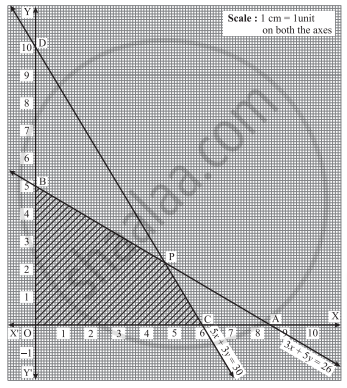Advertisements
Advertisements
Question
Solve the following LPP:
Maximize z = 7x + 11y, subject to 3x + 5y ≤ 26, 5x + 3y ≤ 30, x ≥ 0, y ≥ 0.
Solution
First we draw the lines AB and CD whose equations are 3x + 5y = 26 and 5x + 3y = 30 respectively.
| Line | Equation | Points on the X-axis | Points on the Y-axis | Sign | Region |
| AB | 3x + 5y = 26 | A`(26/3, 0)` | B `(0, 26/5)` | ≤ | origin side of line AB |
| CD | 5x + 3y = 30 | C(6, 0) | D(0, 10) | ≤ | origin side of line CD |

The feasible region is OCPBO which is shaded in the graph.
The vertices of the feasible region are O (0, 0), C (6, 0), P and B `(0, 26/5)`.
The vertex P is the point of intersection of the lines 3x + 5y = 26 .....(1)
and 5x + 3y = 30 .....(2)
Multiplying equation (1) by 3 and equation (2) by 5, we get
9x + 15y = 78
and 25x + 15y = 150
On subtracting, we get
16x = 72
∴ x = `72/16 = 9/2 = 4.5`
Substituting x = 4.5 in equation (2), we get
5(4.5) + 3y = 30
22.5 + 3y = 30
∴ 3y = 7.5
∴ y = 2.5
∴ P is (4.5, 2.5)
The values of the objective function z = 7x + 11y at these corner points are
z(O) = 7(0) + 11(0) = 0 + 0 = 0
z(C) = 7(6) + 11(0) = 42 + 0 = 42
z(P) = 7(4.5) + 11(2.5) = 31.5 + 27.5 = 59.0 = 59
z(B) = 7(0) + 11`(26/5) = 286/5 = 57.2`
∴ z has maximum value 59, when x = 4.5 and y = 2.5.
